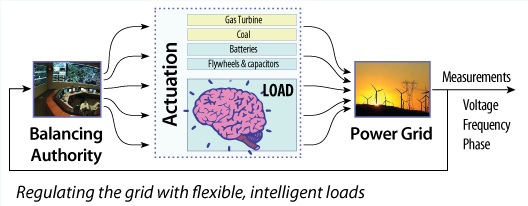It is universally recognized that the volatility of renewable energy poses new challenges to the electric grid. Resources are needed to compensate for uncontrollable fluctuations in power generation. The federal energy regulatory commission (FERC) in conjunction with generation and utility companies are struggling to find resources for providing ancillary services, and finding ways to properly compensate for these services. FERC orders 755 and 745 are examples of such attempts to provide incentives.
Batteries are very expensive is a common explanation for the potentially high cost of volatility. Our response is that storage is everywhere: we do not need to depend entirely on batteries or additional fast-responding gas-generators. In recent work we have shown that most electrical loads can be converted into virtual batteries at low cost without impacting the quality of service (QoS) provide by the loads.
The main idea is illustrated below. Flexible loads ramp up and down their consumption, each in a specific frequency band dictated by QoS constraints. The resulting deviation in power consumption appears to the grid operator exactly the same as a battery used for frequency regulation or balancing reserves.

Buildings as batteries The thermal inertia of a building is analogous to a battery that is charged and discharged to supply ancillary service to the grid. In recent research we have exploited this analogy to create demand response systems based on the heating, ventilation, and air conditioning (HVAC) systems in commercial buildings. Based on building models we argue that there is virtually no change to the indoor climate if the airflow rate in the HVAC system is increased by 10% for 20 minutes, and decreased by 10% for the next 20 minutes.
The amount of untapped virtual storage available from commercial buildings alone is enormous because HVAC systems account for greater than 30% of the electricity consumed in the United States. For frequency regulation, it is demonstrated in [haomidbarey12,haolinkowbarmey14] that a simple software upgrades can be installed in commercial buildings to obtain nearly perfect tracking of the PJM RegD signal, while simultaneously providing perfect climate quality for the building. Experiments conducted on a single typical building on the UF campus showed that several kWs of capacity were available for frequency regulation.
Considering all similar buildings in the U.S., the potential capacity available from fans in buildings in this high frequency bandwidth is about 6 GW, or about 70% of the required frequency regulation reserves required in the U.S. [haolinkowbarmey14]. The potential capacity over a larger bandwidth is far greater: In [linmeybar13] we estimate that potential virtual storage capacity from building HVAC systems in the bandwidth [1/(1 [hour]) \; 1/(10 [min.])] is approximately 42 GW!
Buildings are just a starting point – see our websites for more sources of ancillary service.
@inproceedings{haomidbarey12,
Author = {Hao, He and Middelkoop, Tim and Barooah, Prabir and Meyn, Sean},
Booktitle = {50th {Allerton} Conference on Communication, Control, and Computing},
Pages = {1908-1913},
Title = {How demand response from commercial buildings will provide the regulation needs of the grid},
Year = {2012}}
@inproceedings{linmeybar13,
Author = {Lin, Yashen and Meyn, Sean P. and Barooah, Prabir},
Booktitle = {{Proceedings of IEEE SmartGridComm}},
Month = {October 21-24},
Title = {Low-Frequency Power-Grid Ancillary Services From Commercial Building {HVAC} Systems},
Year = {2013}}
@article{haolinkowbarmey14,
Author = {Hao, H. and Lin, Y. and Kowli, A.S. and Barooah, P. and Meyn, S.},
Journal = {IEEE Trans. on Smart Grid},
Month = {July},
Number = {4},
Pages = {2066-2074},
Title = {Ancillary Service to the Grid Through Control of Fans in Commercial Building {HVAC} Systems},
Volume = {5},
Year = {2014}}
Patents pending
